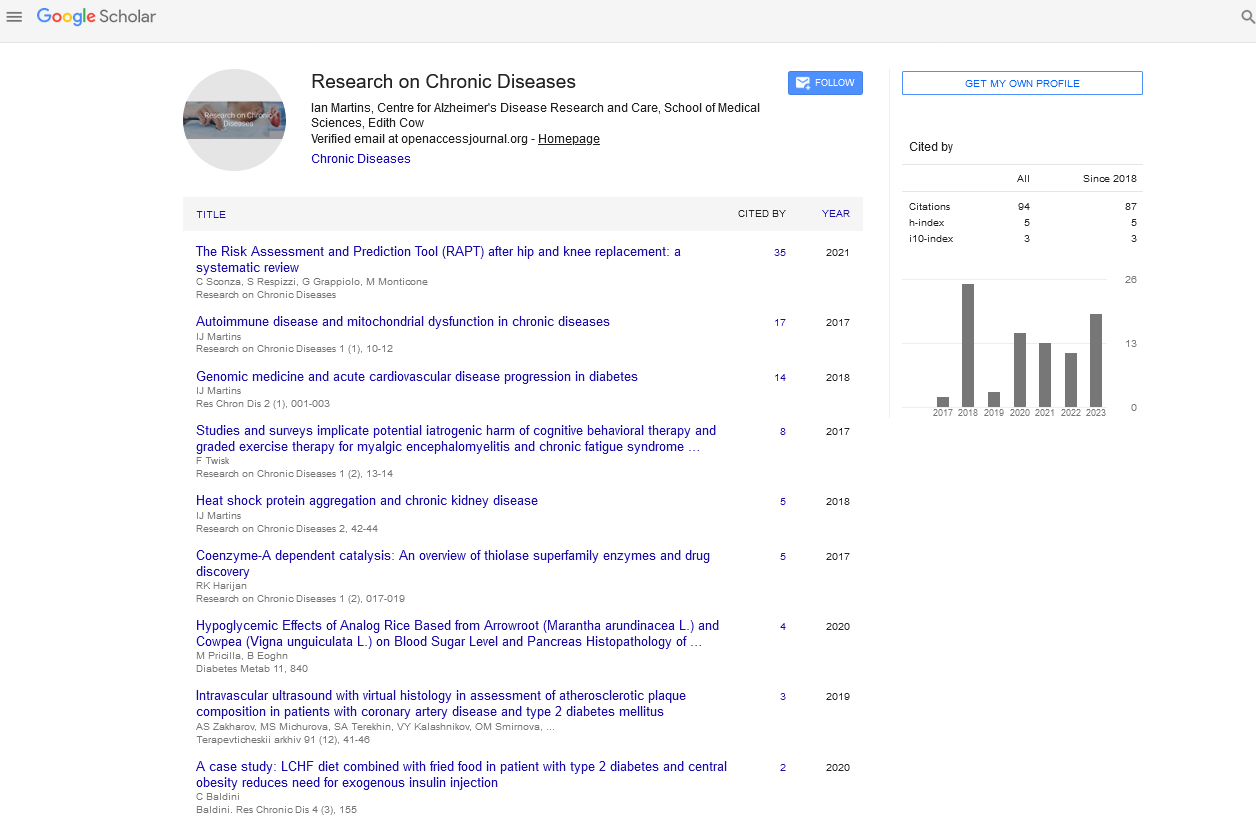Perspective - Research on Chronic Diseases (2024) Volume 8, Issue 5
Chronic Respiratory Diseases: Understanding, Impact, and Management
- Corresponding Author:
- Lencholin Butcher
Department of Pulmonology,
University of Lahinch,
Lahinch,
Ireland
E-mail: butcher33@gamail.com
Received: 04-Jul-2024, Manuscript No. OARCD-24-140611; Editor assigned: 09-Jul-2024, PreQC No. OARCD-24-140611 (PQ); Reviewed: 23-Jul-2024, QC No. OARCD-24-140611; Revised: 01- Oct-2024, Manuscript No. OARCD-24-140611 (R); Published: 29-Oct-2024, DOI: 10.37532/ OARCD.2024.8(5).220-221
Introduction
Chronic Respiratory Diseases (CRDs) represent a significant burden on global health, affecting millions of individuals worldwide. These conditions encompass a wide range of disorders that impair the respiratory system’s function over the long term. From asthma to Chronic Obstructive Pulmonary Disease (COPD) and beyond, CRDs present diverse challenges to both patients and healthcare systems. This article delves into the complexities of chronic respiratory diseases, exploring their causes, impact on health, current treatment options and emerging trends in management.
Description
Understanding chronic respiratory diseases
Chronic respiratory diseases are characterized by persistent respiratory symptoms and airflow limitation. They often result from a combination of genetic predisposition and environmental factors, such as exposure to tobacco smoke, air pollution, occupational hazards and indoor allergens. Among the most prevalent CRDs are asthma, COPD, pulmonary hypertension and interstitial lung diseases. Each condition manifests uniquely in terms of symptoms, disease progression and response to treatment.
Asthma: Asthma is a chronic inflammatory disorder of the airways, causing recurrent episodes of wheezing, breathlessness, chest tightness and coughing. It affects people of all ages and is often triggered by allergens, exercise or respiratory infections.
Pulmonary hypertension: This condition involves elevated blood pressure in the pulmonary arteries, leading to strain on the right side of the heart and potentially heart failure. Pulmonary hypertension can be idiopathic or associated with other conditions like COPD or autoimmune diseases.
Interstitial lung diseases: These are a group of disorders characterized by inflammation and fibrosis of the lung interstitium, affecting the tissue and spaces around the air sacs. Examples include idiopathic pulmonary fibrosis and sarcoidosis, which impair lung function and gas exchange.
Impact on health and quality of life
The impact of CRDs on individuals extends beyond physical symptoms to encompass psychological, social and economic aspects. Patients with chronic respiratory diseases often experience reduced quality of life due to breathlessness, fatigue, limitations in physical activity and frequent exacerbations requiring medical intervention. Moreover, these conditions can lead to complications such as respiratory failure, pulmonary hypertension and increased susceptibility to respiratory infections.
From a societal perspective, CRDs impose a substantial economic burden through healthcare costs, lost productivity and disability. The World Health Organization (WHO) identifies CRDs as a major cause of morbidity and mortality globally, highlighting the urgency of effective management strategies and public health interventions.
Current treatment strategies
The management of chronic respiratory diseases aims to alleviate symptoms, improve lung function, prevent disease progression and enhance quality of life. Treatment approaches vary depending on the specific condition and its severity but generally include:
Pharmacological interventions: Medications such as bronchodilators, corticosteroids and monoclonal antibodies target inflammation, bronchoconstriction and mucus production in diseases like asthma and COPD.
Pulmonary rehabilitation: A multidisciplinary approach involving exercise training, education and nutritional counseling helps improve exercise capacity and daily functioning in patients with CRDs.
Oxygen therapy: Supplemental oxygen is prescribed for patients with severe hypoxemia to improve oxygen delivery to tissues and organs, reducing the workload on the heart and improving survival rates.
Surgical interventions: In some cases, surgical procedures such as lung transplantation or lung volume reduction surgery may be considered for patients with advanced disease or specific complications.
Emerging trends and future directions
Research and innovation continue to drive advancements in the management of CRDs, with promising developments in several areas:
Precision medicine: Tailoring treatment strategies based on genetic, molecular and environmental factors to optimize outcomes and minimize adverse effects.
Biologics and targeted therapies: The development of biologic agents targeting specific inflammatory pathways has shown efficacy in severe asthma and other inflammatory CRDs, offering new avenues for personalized treatment.
Telemedicine and digital health: Remote monitoring, teleconsultations and mobile health applications facilitate access to healthcare services, enhance disease management and improve adherence to treatment regimens.
Environmental and policy interventions: Advocacy for clean air policies, smoking cessation programs and occupational safety measures aims to reduce exposure to risk factors contributing to CRDs on a population level.
Conclusion
Chronic respiratory diseases pose a formidable challenge to global health, affecting millions of individuals and placing significant strain on healthcare systems worldwide. Understanding the diverse nature of CRDs, from asthma to COPD and beyond, underscores the importance of personalized, multidisciplinary approaches to management. Advances in pharmacotherapy, pulmonary rehabilitation and digital health solutions offer hope for improved outcomes and quality of life for patients living with these debilitating conditions. As research continues to unravel the complexities of CRDs and therapeutic options evolve, concerted efforts in prevention, early detection and effective management remain pivotal in reducing the burden of chronic respiratory diseases on individuals and society as a whole.
